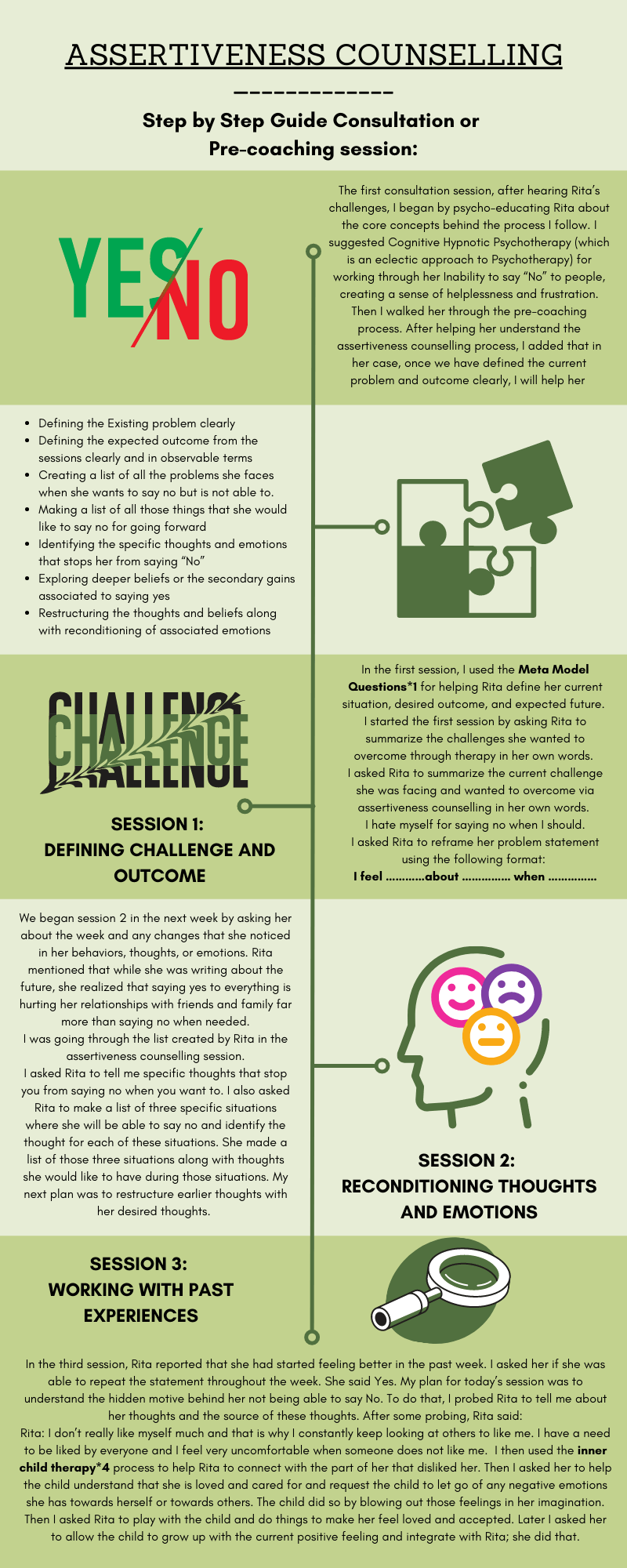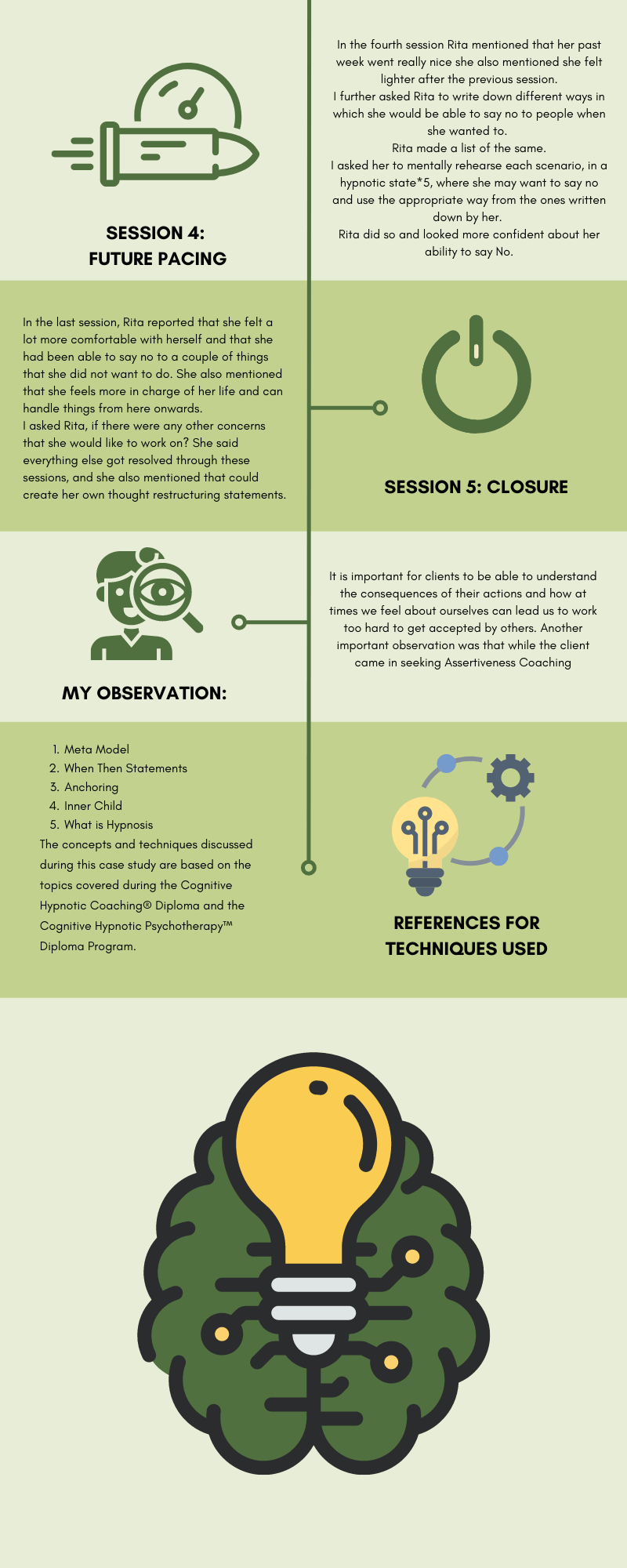Recently, I received a call from Rita (name changed) who had the Inability to say “No” to people, creating a sense of helplessness and frustration. She was wondering whether assertiveness coaching can help her.
After having an initial conversation over the phone, we planned for a consultation session.
Assertiveness Counselling – Step by Step Guide
Consultation or Pre-coaching session:

Rita: I have a habit of saying yes to everything assigned to me. I am unable to say “No” even when I know that is the right thing to say. There are also times when I know that I wouldn’t be able to do something or that I don’t have time to do it but still I’m not able to say “No”.
I feel frustrated because this leaves me no time to complete my tasks. This pattern is evident not only in my personal life but also in my professional life. I decide to say “no” the next time someone asks for my help but when the time comes, I actually say yes again. Every time I do that, I hate myself. And Nitin, at the same time, I fear people will start disliking me, I won’t be a good person and people will think that I am selfish, if I say “no”. Actually, I think that by saying no, I will bring criticism to myself and my friends will leave me. This again stops me from saying “no”.
As always in the first consultation session, after hearing Rita’s challenges, I began by psycho-educating Rita about the core concepts behind the process I follow. I suggested Cognitive Hypnotic Psychotherapy (which is an eclectic approach to Psychotherapy) for working through her Inability to say “No” to people, creating a sense of helplessness and frustration. Then I walked her through the pre-coaching process. After helping her understand the assertiveness counselling process, I added that in her case, once we have defined the current problem and outcome clearly, I will help her
- Defining the Existing problem clearly
- Defining the expected outcome from the sessions clearly and in observable terms
- Creating a list of all the problems she faces when she wants to say no but is not able to.
- Making a list of all those things that she would like to say no for going forward
- Identifying the specific thoughts and emotions that stops her from saying “No”
- Exploring deeper beliefs or the secondary gains associated to saying yes
- Restructuring the thoughts and beliefs along with reconditioning of associated emotions
Rita said was not aware of any beliefs or any secondary gains behind constantly saying yes even when I don’t want to. I explained to her by saying that during the sessions with the help of exploratory questions and different imagination-based processes she will be able to identify and work with these beliefs and secondary gains if any.
Session 1: Defining Challenge and Outcome
In the first session, I used the Meta Model Questions*1 for helping Rita define her current situation, desired outcome, and expected future.
I started the first session by asking Rita to summarize the challenges she wanted to overcome through therapy in her own words.
I asked Rita to summarize the current challenge she was facing and wanted to overcome via assertiveness counselling in her own words.
I hate myself for saying no when I should.
I asked Rita to reframe her problem statement using the following format:
I feel ……………………. about ………………………… when ……………………………
Rita: I feel helpless and frustrated about my inability to say no when I want to
I asked Rita to read the statement a couple of times and tell me what was the desired outcome that she wanted to achieve at the end of these sessions in the format:

I wish ……………………….
Rita: I wish to be able to say “No” to things that I don’t agree with or don’t have the time to do.
I asked Rita to list down all the problems she faces as a result of constantly saying yes.
Rita created a list of all the problems she faces as a result of not being able to say no including the way she feels about herself and how it is creating problems between herself and her friends as she keeps over-committing and then is not able to completely fulfill her commitment.
For the home assignment, I asked her to create a list of all the benefits of being able to say No, when she needs to.
Session 2: Reconditioning Thoughts and Emotions
We began session 2 in the next week by asking her about the week and any changes that she noticed in her behaviors, thoughts, or emotions. Rita mentioned that while she was writing about the future, she realized that saying yes to everything is hurting her relationships with friends and family far more than saying no when needed.
I was going through the list created by Rita in the assertiveness counselling session.
I asked Rita to tell me specific thoughts that stop you from saying no when you want to. I also asked Rita to make a list of three specific situations where she will be able to say no and identify the thought for each of these situations. She made a list of those three situations along with thoughts she would like to have during those situations. My next plan was to restructure earlier thoughts with her desired thoughts. I helped Rita do so with the help of the When-Then Statements*2.
I further asked her to write her desired emotion next to each situation. Rita said that she would like to feel confident while saying no.
I did the NLP anchoring process*3 with her.
For the home assignment, I asked her to keep repeating the restructured thought throughout the week.
Session 3: Working with Past Experiences

In the third session, Rita reported that she had started feeling better in the past week. I asked her if she was able to repeat the statement throughout the week. She said Yes.
My plan for today’s session was to understand the hidden motive behind her not being able to say No.
To do that, I probed Rita to tell me about her thoughts and the source of these thoughts. After some probing, Rita said:
Rita: I don’t really like myself much and that is why I constantly keep looking at others to like me. I have a need to be liked by everyone and I feel very uncomfortable when someone does not like me.
I then used the inner child therapy*4 process to help Rita to connect with the part of her that disliked her. Then I asked her to help the child understand that she is loved and cared for and request the child to let go of any negative emotions she has towards herself or towards others. The child did so by blowing out those feelings in her imagination. Then I asked Rita to play with the child and do things to make her feel loved and accepted. Later I asked her to allow the child to grow up with the current positive feeling and integrate with Rita; she did that.
I asked Rita what was she feeling at that moment? She said she was feeling Calm.
I further asked her to tell me 3 situations in the future where she would like to experience calmness.
Once she shared those 3 future situations, I did the NLP Anchoring process.
At the end of the process, Rita had a visible glow on her face and felt very happy.
Session 4: Future Pacing
In the fourth session Rita mentioned that her past week went really nice she also mentioned she felt lighter after the previous session.
I further asked Rita to write down different ways in which she would be able to say no to people when she wanted to.
Rita made a list of the same.
I asked her to mentally rehearse each scenario, in a hypnotic state*5, where she may want to say no and use the appropriate way from the ones written down by her.
Rita did so and looked more confident about her ability to say No.
Session 5: Closure
In the last session, Rita reported that she felt a lot more comfortable with herself and that she had been able to say no to a couple of things that she did not want to do. She also mentioned that she feels more in charge of her life and can handle things from here onwards.
I asked Rita, if there were any other concerns that she would like to work on? She said everything else got resolved through these sessions, and she also mentioned that could create her own thought restructuring statements.
My Observation:
It is important for clients to be able to understand the consequences of their actions and how at times we feel about ourselves can lead us to work too hard to get accepted by others. Another important observation was that while the client came in seeking Assertiveness Coaching
References for techniques used
The concepts and techniques discussed during this case study are based on the topics covered during the Cognitive Hypnotic Coaching® Diploma and the Cognitive Hypnotic Psychotherapy™ Diploma Program.

